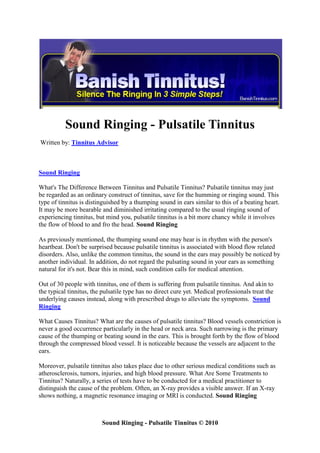Sound ringing pulsatile tinnitus
- 1. Sound Ringing - Pulsatile Tinnitus
Written by: Tinnitus Advisor
Sound Ringing
What's The Difference Between Tinnitus and Pulsatile Tinnitus? Pulsatile tinnitus may just
be regarded as an ordinary construct of tinnitus, save for the humming or ringing sound. This
type of tinnitus is distinguished by a thumping sound in ears similar to this of a beating heart.
It may be more bearable and diminished irritating compared to the usual ringing sound of
experiencing tinnitus, but mind you, pulsatile tinnitus is a bit more chancy while it involves
the flow of blood to and fro the head. Sound Ringing
As previously mentioned, the thumping sound one may hear is in rhythm with the person's
heartbeat. Don't be surprised because pulsatile tinnitus is associated with blood flow related
disorders. Also, unlike the common tinnitus, the sound in the ears may possibly be noticed by
another individual. In addition, do not regard the pulsating sound in your ears as something
natural for it's not. Bear this in mind, such condition calls for medical attention.
Out of 30 people with tinnitus, one of them is suffering from pulsatile tinnitus. And akin to
the typical tinnitus, the pulsatile type has no direct cure yet. Medical professionals treat the
underlying causes instead, along with prescribed drugs to alleviate the symptoms. Sound
Ringing
What Causes Tinnitus? What are the causes of pulsatile tinnitus? Blood vessels constriction is
never a good occurrence particularly in the head or neck area. Such narrowing is the primary
cause of the thumping or beating sound in the ears. This is brought forth by the flow of blood
through the compressed blood vessel. It is noticeable because the vessels are adjacent to the
ears.
Moreover, pulsatile tinnitus also takes place due to other serious medical conditions such as
atherosclerosis, tumors, injuries, and high blood pressure. What Are Some Treatments to
Tinnitus? Naturally, a series of tests have to be conducted for a medical practitioner to
distinguish the cause of the problem. Often, an X-ray provides a visible answer. If an X-ray
shows nothing, a magnetic resonance imaging or MRI is conducted. Sound Ringing
Sound Ringing - Pulsatile Tinnitus © 2010
- 2. It is important for a patient to tell the doctor how and when the symptoms first took place.
This is vital so that the attending physician can thoroughly order the crucial tests to be done,
so as not to leave any stone unturned. Suffering from Ringing Ears and Tinnitus? Get your
life back forever by checking out Sound Ringing now.
Tinnitus Advisor
“Been suffering from Tinnitus? Get Sound Ringing to END it now!
Try the Program now and get back your Life!”
Sound Ringing - Pulsatile Tinnitus © 2010

